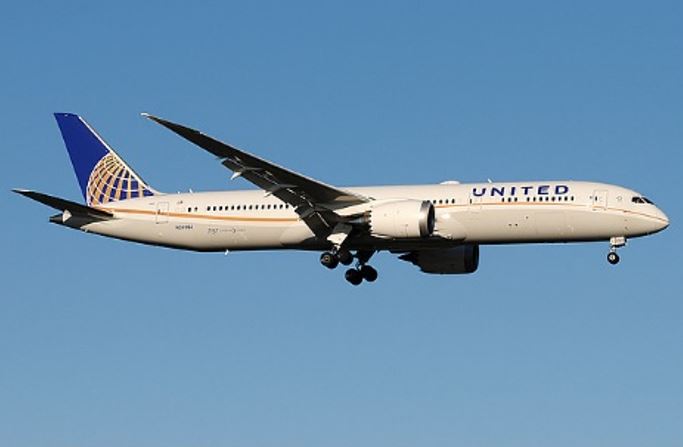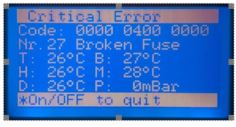Boeing 787, N36962

Source: John Richard Thomson
What happened
On 17 April 2016, a Boeing 787-9, registered N36962, operated by United Airlines as flight UAL870, departed Sydney, New South Wales (NSW), for San Francisco, United States. On board were 4 flight crew, 11 cabin crew and 238 passengers. During the departure, cabin crew switched on the aft galley ovens (Figure 1) in preparation for meal services.
After the two ovens were switched on, there was a short burst of smoke, which set off a fire alarm in a nearby toilet for about one minute. One of the ovens displayed a “FAILURE” message. Several cabin crew detected a strong chemical odour and an electrical smell, as well as a blue haze. Other crew described it as an ozone smell. The oven interactive screen displayed a ‘Critical Error- Broken Fuse’ message.
The crew immediately pulled all relevant circuit breakers, and switched off all electrical sources to the aft galley. The inflight service manager (ISM) advised the captain. The ISM and a relief pilot from the cockpit arrived at the aft galley with fire extinguishers. By this stage, the smoke had dissipated, but the odour persisted. As it could not be confidently ascertained that the ovens were the sole source of the problem, the captain contacted the ground-based technical operations maintenance controller (TOMC) by satellite phone.
Figure 1: Rear section of a B787-9 depicting aft galley

Source: SeatGuru modified by the ATSB
The discussion with the TOMC involved all flight crew and the ISM. It was agreed that the safest option was to return the aircraft to Sydney. The captain advised ATC by a PAN[1] call. ATC initiated an INCERFA[2] phase. About 110 km east of Port Macquarie, NSW, the crew commenced a return to Sydney. As the aircraft was well in excess of its allowed landing weight, fuel was dumped during the descent.
The aircraft landed without incident in Sydney at 1258 Eastern Standard Time (EST) with emergency services in attendance.
Post-incident engineering report
A post-engineering inspection quarantined the suspect oven, and after an inspection, a fuse was replaced. After appropriate testing, the aircraft was released back to service.
Boeing and the oven manufacturer investigated the cause of the ‘Critical Error’ fault displayed on the oven screen (Figure 2).
The manufacturer individually tested all oven components. They reported that all individual components worked correctly, however, an additional measurement of the oven motor current detected that the motor did not run smoothly. The motor temperature was also above normal, most likely from insufficient airflow. This known fault had been rectified with a new oven software release.
Boeing reported that the oven manufacturer is working with United Airlines to update the software in all relevant ovens in their fleet.
The exact cause of the odour could not be determined.
A second similar occurrence
United Airlines have advised the ATSB of a second similar occurrence involving another B787 aircraft. On 2 June 2016, a United Airlines B787 aircraft, N35953 experienced an electrical/heat odour in the mid B galley. The flight crew dumped excess fuel and returned safely to Melbourne. On this occasion, no emergency was declared.
Maintenance were able to isolate one oven, and confirmed the error was a broken fuse. The oven was removed and replaced, and the aircraft returned to service.
Figure 2: Error message from oven on N35953

ATSB comment
As part of the investigation, the ATSB obtained reports from the flight crew and cabin crew on board during the incident.
It was evident that all emergency procedures were carried out efficiently and effectively. The captain involved all relevant crew members and the TOMC prior to making a decision to return the aircraft to Sydney.
Safety message
This incident highlights the correct management of an abnormal situation with effective crew coordination. Each crew member responded effectively and the situation was professionally managed by the captain.
Aviation Short Investigations Bulletin - Issue 50
Purpose of safety investigationsThe objective of a safety investigation is to enhance transport safety. This is done through:
It is not a function of the ATSB to apportion blame or provide a means for determining liability. At the same time, an investigation report must include factual material of sufficient weight to support the analysis and findings. At all times the ATSB endeavours to balance the use of material that could imply adverse comment with the need to properly explain what happened, and why, in a fair and unbiased manner. The ATSB does not investigate for the purpose of taking administrative, regulatory or criminal action. TerminologyAn explanation of terminology used in ATSB investigation reports is available here. This includes terms such as occurrence, contributing factor, other factor that increased risk, and safety issue. Publishing informationReleased in accordance with section 25 of the Transport Safety Investigation Act 2003 Published by: Australian Transport Safety Bureau © Commonwealth of Australia 2016
Ownership of intellectual property rights in this publication Unless otherwise noted, copyright (and any other intellectual property rights, if any) in this report publication is owned by the Commonwealth of Australia. Creative Commons licence With the exception of the Coat of Arms, ATSB logo, and photos and graphics in which a third party holds copyright, this publication is licensed under a Creative Commons Attribution 3.0 Australia licence. Creative Commons Attribution 3.0 Australia Licence is a standard form licence agreement that allows you to copy, distribute, transmit and adapt this publication provided that you attribute the work. The ATSB’s preference is that you attribute this publication (and any material sourced from it) using the following wording: Source: Australian Transport Safety Bureau Copyright in material obtained from other agencies, private individuals or organisations, belongs to those agencies, individuals or organisations. Where you wish to use their material, you will need to contact them directly. |
__________
- An internationally recognised radio call announcing an urgency condition which concerns the safety of an aircraft or its occupants but where the flight crew does not require immediate assistance.
- INCERFA is an uncertain ty phase when doubt exists as to the safety of the aircraft and its occupants


